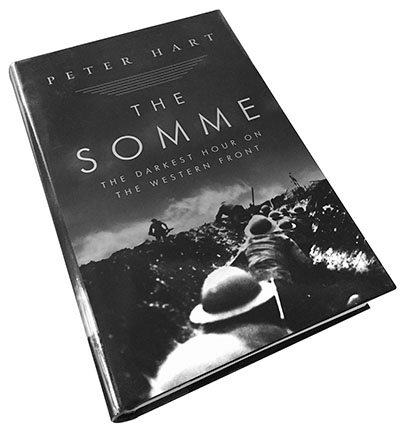The Somme

A Dark Hour but a first class history
By Martin Hornbyon
'The Somme'. To many people these few words have come to be bywords for murder, mayhem and pointless slaughter. They conjure up views of Chateau Generals and poor Tommy Atkins living in fetid trenches waiting an untimely death in a hail of machine gun bullets.
At long last we have a book which challenges this often heard view of the battle of the Somme. For nearly 90 years many eminent military historians have helped to colour the views of our nation with the same old bigoted, jaundiced and ill informed view of this great but tragic battle.
In this work Peter Hart looks at the battle in a logical and orderly manner. The book starts by giving the reasons why Douglas Haig was forced into fighting on the chalk downlands of the Somme. Once the political reasons for the battle are covered he moves smoothly to the tumultuous first day. This starts at Gommecourt and steadily moves southwards along the battleline to Maricourt on the banks of the river Somme. All through the text one sees an educated analysis of the opening day's events, which are greatly aided by new facsimiles of the Official Histories maps.
Upon the conclusion of the first day the reader is then taken through the further battles that comprise the Battle of the Somme. All the time there is logical analysis of the Generals actions. In many parts one is made aware of unforgivable errors made by Haig, Rawlinson and others which lead to the death of many thousands of men. But one is also made aware of incidents that will hopefully lay down the myth of Lions led by Donkeys! The analysis of the battles is clear and concise, sticking to known facts. All too often we are served up myth and legend, in what are frankly pseudo histories of this conflict.
Throughout the book Peter Hart makes extensive use of personal accounts from those who we there. He has not been tempted to colour the reader's judgement of the overall battle by the misrepresentation of these most personal reminiscences. They add greatly to the understanding of how individual soldiers felt about their own localised situation within the tumult of the battle.
In conclusion I would recommend this book whole heartedly; this is a classic work that joins the ever increasing list of revisionist histories on the Great War. With the passing of time we are able to make reasoned judgements on the conflict. Peter Hart should be congratulated for producing this fine body of work. I would suggest that those who have accused him of being an apologist for Douglas Haig should question their own historical integrity and stop following the all too easy path of misinformed and some what bigoted comment on this tragic battle.
The one abiding conclusion to be drawn from this book is that War is awful, it is not and never has been glorious to those who are caught up in it. Peter Hart leaves one in no doubt of this fact.